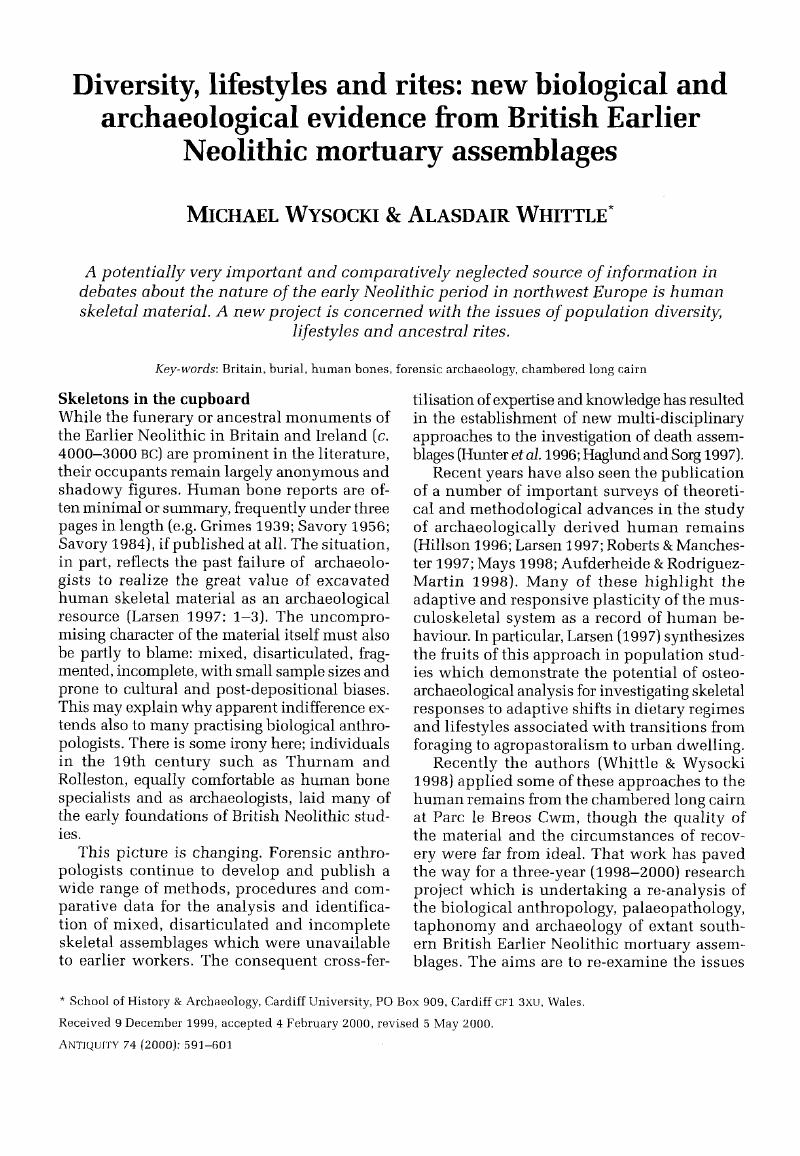Crossref Citations
This article has been cited by the following publications. This list is generated based on data provided by Crossref.
Brickley, Megan
and
Thomas, Richard
2004.
The Young Woman and her Baby or the Juvenile and their Dog: Reinterpreting Osteological Material from a Neolithic Long Barrow.
Archaeological Journal,
Vol. 161,
Issue. 1,
p.
1.
Smith, M. J.
and
Brickley, M. B.
2004.
Analysis and interpretation of flint toolmarks found on bones from West Tump long barrow, Gloucestershire.
International Journal of Osteoarchaeology,
Vol. 14,
Issue. 1,
p.
18.
Schulting, Rick J.
and
Wysocki, Michael
2005.
‘In this Chambered Tumulus were Found Cleft Skulls …’: an Assessment of the Evidence for Cranial Trauma in the British Neolithic.
Proceedings of the Prehistoric Society,
Vol. 71,
Issue. ,
p.
107.
SMITH, MARTIN
and
BRICKLEY, MEGAN
2006.
THE DATE AND SEQUENCE OF USE OF NEOLITHIC FUNERARY MONUMENTS: NEW AMS DATING EVIDENCE FROM THE COTSWOLD‐SEVERN REGION.
Oxford Journal of Archaeology,
Vol. 25,
Issue. 4,
p.
335.
Thomas, Richard
and
McFadyen, Lesley
2010.
Animals and Cotswold-Severn Long Barrows: a Re-examination.
Proceedings of the Prehistoric Society,
Vol. 76,
Issue. ,
p.
95.
Beckett, Jessica F.
2011.
Interactions with the Dead: A Taphonomic Analysis of Burial Practices in Three Megalithic Tombs in County Clare, Ireland.
European Journal of Archaeology,
Vol. 14,
Issue. 3,
p.
394.
Edwards, Benjamin
and
Pope, Rachel
2012.
A Companion to Gender Prehistory.
p.
458.
Henderson, C.Y.
2013.
Do diseases cause entheseal changes at fibrous entheses?.
International Journal of Paleopathology,
Vol. 3,
Issue. 1,
p.
64.
Henderson, C.
2013.
Subsistence strategy changes: The evidence of entheseal changes.
HOMO,
Vol. 64,
Issue. 6,
p.
491.
HENDERSON, C.Y.
2013.
Technical note: Quantifying size and shape of entheses.
Anthropological Science,
Vol. 121,
Issue. 1,
p.
63.
Wysocki, Michael
Griffiths, Seren
Hedges, Robert
Bayliss, Alex
Higham, Tom
Fernandez-Jalvo, Yolanda
and
Whittle, Alasdair
2013.
Dates, Diet, and Dismemberment: Evidence from the Coldrum Megalithic Monument, Kent.
Proceedings of the Prehistoric Society,
Vol. 79,
Issue. ,
p.
61.
Stojanowski, Christopher M.
Carver, Charisse L.
and
Miller, Katherine A.
2014.
Incisor avulsion, social identity and Saharan population history: New data from the Early Holocene southern Sahara.
Journal of Anthropological Archaeology,
Vol. 35,
Issue. ,
p.
79.
Tilley, Lorna
2015.
Theory and Practice in the Bioarchaeology of Care.
p.
259.
Crozier, Rebecca
2016.
Fragments of death. A taphonomic study of human remains from Neolithic Orkney.
Journal of Archaeological Science: Reports,
Vol. 10,
Issue. ,
p.
725.
Rothschild, B.M.
Wilhite, D.R.
McLeod, D.S.
and
Ting, H.
2016.
Evidence from surface microscopy for recognition of fleshy and tendinous muscle insertion in extant vertebrate femora: implications for muscle reconstruction in fossils.
Historical Biology,
Vol. 28,
Issue. 6,
p.
842.
Neil, Samantha
Montgomery, Janet
Evans, Jane
Cook, Gordon T.
and
Scarre, Chris
2017.
Land use and mobility during the Neolithic in Wales explored using isotope analysis of tooth enamel.
American Journal of Physical Anthropology,
Vol. 164,
Issue. 2,
p.
371.
Acosta, M. A.
Henderson, C. Y.
and
Cunha, E.
2017.
The Effect of Terrain on Entheseal Changes in the Lower Limbs.
International Journal of Osteoarchaeology,
Vol. 27,
Issue. 5,
p.
828.
Robb, John
and
Harris, Oliver J. T.
2018.
BECOMING GENDERED IN EUROPEAN PREHISTORY: WAS NEOLITHIC GENDER FUNDAMENTALLY DIFFERENT?.
American Antiquity,
Vol. 83,
Issue. 1,
p.
128.
Booth, Thomas J.
and
Brück, Joanna
2020.
Death is not the end: radiocarbon and histo-taphonomic evidence for the curation and excarnation of human remains in Bronze Age Britain.
Antiquity,
Vol. 94,
Issue. 377,
p.
1186.
Hammann, Simon
and
Cramp, Lucy J.E.
2021.
Comprehensive Foodomics.
p.
197.



